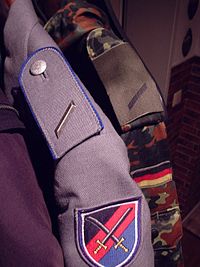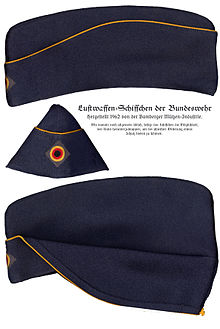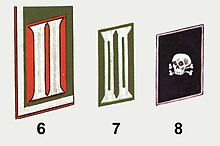
In the German military, Waffenfarbe (German: "branch-of-service colors" or "corps colors") is a visual method that the armed forces use to distinguish between different corps or troop functions in its armed services. The Waffenfarbe itself can take the form of the color of the collar patch, of the piping (embellishment) around the shoulder boards or shoulder marks, or—for enlisted ranks—of the piping around the collar and the garrison cap (Schiffchen). (In the latter places, NCOs wear cords of dark gold, officers silver, and generals gold.)
Present
Army
The Bundeswehr uses a Waffenfarben color scheme to indicate troop types; they appear on the collar patch and as piping around the shoulder boards or straps showing a soldier's rank.
Colored soldiers' berets are slightly less differentiated than the Waffenfarben; in fact, corps or troop function is indicated by a beret badge.
Heer (army)
-
 NBC
NBC
-
 Artillery
Artillery
-
 MP
MP
-
 Signals
Signals
-
 Reconnaissance
Reconnaissance
-
 Army Aviation
Army Aviation
-
 Logistics
Logistics
-
 Infantry
Infantry
-
 Military band
Military band
-
 Armoured forces
Armoured forces
-
 Engineers
Engineers
-
 Medical troops
Medical troops
Luftwaffe (air force)

The German Air Force uses a restricted color spectrum. While the air force normally uses golden yellow, officers "in the general staff service" (im Generalstabsdienst – there is no general staff as such in the Bundeswehr) wear wine-red, and generals bright red. The collar patches (Kragenspiegel) of generals and general staff service officers also differ from the normal air force design, as they are identical with the army ones.
Deutsche Marine (navy)
The German Navy uses various emblems above the rank stripes on the sleeves rather than function-specific colors to distinguish between corps. It traditionally did not use Waffenfarben.
History
Waffenfarben used by the Deutsches Heer (1871–1919)
The Imperial German Army before 1915 did not have any defined use of Waffenfarben, except for cavalry. The Waffenfarben used in shoulder strap piping of the M1907/10 Feldrock was instead related to army corps, with exceptions to certain regiments due to seniority or distinctions.
| Army Corps and regiments | Colors |
|---|---|
| I, II, IX, X, XII, and I Bavarian
1st and 5th Foot Guards; 1st and 5th Guard Grenadiers; 109th, 110th, 116th Infantry Regiments |
White |
| III, IV XI, XIII XV, XIX, and II Bavarian
2nd Foot Guards; 2nd Guard Grenadiers; 11th Battalion of the 89th Grenadiers; 111th, 115th, 168th, 169th, 171st, 172nd Infantry Regiments |
Red |
| V, VI, XVI, XVII, and III Bavarian
3rd Foot Guards; 3rd Guard Grenadiers; Guards Fusiliers; 112th, 118th, 142nd Infantry Regiments |
Yellow |
| VII, VIII, XVIII, XX
4th Foot Guards, 4th Guard Grenadiers; 40th, 113th, 145th, 170th Infantry Regiments |
Blue |
| XXI
114th Infantry Regiment |
Green |
Branch of service was distinguished using colors on uniforms with the piping on the collars and cuffs of the uniform. This was only available in red (standard) for infantry, black for engineers and technical troops and green for Jägers. Other distinctions were made on the Feldmütze cap band.
In 1915 new regulations were introduced which simplified the earlier uniforms and introduced an early form of Waffenfarben for different services, however some regimental distinctions still remained.
| Service branch or Regiments | Colors |
|---|---|
| Infantry | White |
| Jäger (light infantry) | Dark green |
| General Officers | Red |
| Foot Artillery | Gold |
| Dragoon | Cornflower Blue |
| Pioneer (Combat engineer) | Black |
| Supply Troops | Blue |
| Telegraph Troops | Grey |
Waffenfarben used by the Reichsheer (1921–1935)
| Regiment or Battalion type | Colors |
|---|---|
| General Officers |
Scarlet (Hochrot) |
| Staff Corps of the Reichsheer Veterinary service |
Carmine (Karmesin) |
| Infantry | White |
| Motor Transport | Rose-pink (Rosa) |
| Signals | Light brown |
| Cavalry | Golden yellow |
| Jäger (light infantry) | Dark green |
| Transport (horse-drawn) | Light blue |
| Medical Service | Dark blue |
| Pioneer (Combat engineer) | Black |
Waffenfarben used by the Wehrmacht (1935–1945)
Main articles: Corps colours of the German Army (1935–1945) and Corps colours of the Luftwaffe (1935–1945)




In the German Heer and Luftwaffe, there was a strictly defined systematic of Waffenfarben on collar patches, and as uniform piping around the shoulder boards or shoulder straps. The Waffenfarben of the Reichswehr (1921 until c. 1935) were almost identical to those of the Wehrmacht.
Waffenfarben used by the SS (1938–1945)
Main article: Corps colours (Waffen-SS)Waffenfarben worn by the National People's Army (1956–1990)
Main article: Corps colours (NPA)East German (DDR) Nationale Volksarmee uniforms initially wore the Waffenfarben as worn by the Wehrmacht. Between 1974 and 1979, along with the introduction of uniforms with open collar and tie, the patches of the ground force uniforms were unified with a dark gray base and a white filling, along with a white collar piping; the piping of the shoulder boards/shoulder straps remained the only part carrying a Waffenfarbe. However, air/air defense forces, paratroopers, and generals as well as the navy continued to wear their specially designed Waffenfarbe patches.
The uniform of the Border Troops was distinguished from that of the NVA ground force and Air Force/Air Defense Force by a green armband with large silver letters identifying the wearer's affiliation, and a green cap band.
Similarities in other armies
The use of Waffenfarbe to distinguish between troop functions was not unique to the Wehrmacht during World War II. After 1942, the Soviet Army, too, used analogous shoulder boards to distinguish troop functions: ground forces general officers and infantry used crimson, cavalry used blue, artillery and tank troops used red, and the rest of the ground forces used black, while the air force and airborne troops used sky blue. Likewise the British Army utilized analogous strips of cloth on the sleeves to likewise identify troop functions.
Today, Waffenfarbe schemes are also used in Austria, Finland, France, Hungary, Italy, Japan, Poland, Romania, Somalia and Switzerland. For a full list of analogous troop function insignia currently in use of the US Army, see United States Army branch insignia.
Main article: Waffenfarbe (Austria)See also
References
- Official brochure on Bundeswehr uniforms (in German) Archived December 27, 2008, at the Wayback Machine (Waffenfarben of the army p. 14, of the air force p. 17)
- https://www.kaisersbunker.com/gtp/m10feldrock.htm
- https://www.kaisersbunker.com/ht/farben/farben2.htm
- https://www.kaisersbunker.com/gtp/m15bluse.htm
- In addition to the Waffenfarbe, monograms and symbols were used to denominate services or units.
- The illustration erroneously depicts the NCO braid running around the lower edge of the collar, as on field uniforms. On actual dress uniforms the Tresse encircled the upper edge.
- Klaus-Ulrich Keubke, Manfred Kunz: Uniformen der Nationalen Volksarmee der DDR 1956-1986. Brandenburgisches Verlagshaus, Berlin 1990, p. 159, 175
- Glossary of German military terms
- Adolf Schlicht, John R. Angolia: Die deutsche Wehrmacht, Uniformierung und Ausrüstung 1933-1945
Vol. 1: Das Heer (ISBN 3613013908), Motorbuch Verlag, Stuttgart 1992
Vol. 3: Die Luftwaffe (ISBN 3-613-02001-7), Motorbuch Verlag, Stuttgart 1999
(very detailed information and discussion, but not colorized)